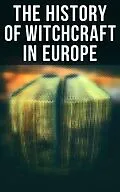The History of Witchcraft in Europe' is a compelling anthology that traverses the murky waters of witchcraft's past through a diverse array of literary styles. This collection encapsulates a wide-ranging chronicle from medieval superstitions and the horrors of the witch hunts to the Romantic reinterpretation of witch folklore within a modern scholarly framework. The anthology highlights not only the dark narratives that have swirled around this theme but also represents pivotal transformations in the portrayal of witchcraft, underscored by critical texts which reveal the shifting intersection of fear, mysticism, and power dynamics in European societies. The authors contributing to this anthology, such as John Ashton, Bram Stoker, and Margaret Murray, bring a rich tapestry of backgrounds influenced by various movements like Romanticism and the Enlightenment while embodying unique philosophical, historical, and literary insights. Their collective works offer a nuanced understanding of the sociopolitical fears and theological battles that historically fueled the witchcraft craze and its subsequent study. This anthology serves as a crucible where the myriad perspectives and interpretations regarding European witchcraft meld together, reflecting their disparate cultural contexts and personal ideologies. Reaching into 'The History of Witchcraft in Europe' provides an enriching academic experience. For the erudite reader and the curious novice alike, this anthology offers a panoramic view into the diverse narratives and analyses about witchcraft, presenting an opportunity to engage with the subject's complexity through well-crafted scholarship. The collection encourages readers to appreciate the historical evolution of witchcraft within Europe, challenging them to consider broader questions about human nature, fear, and the societal construct of otherness.
Zusammenfassung
Witchcraft in Europe was believed to be a combination of sorcery and heresy. While sorcery attempts to produce negative supernatural effects through formulas and rituals, heresy is the Christian contribution to witchcraft in which an individual makes a pact with the Devil. In addition, heresy denies witches the recognition of important Christian values such as baptism, salvation, Christ and sacraments. In Early Modern European tradition, witches were stereotypically, though not exclusively, women. European pagan belief in witchcraft was associated with the goddess Diana and dismissed as "diabolical fantasies" by medieval Christian authors. Witch-hunts first appeared in large numbers during the 14th and 15th centuries. It was commonly believed that individuals with power and prestige were involved in acts of witchcraft and even cannibalism.Table of Contents:The Superstitions of Witchcraft by Howard WilliamsThe Devil in Britain and America by John AshtonLives of the Necromancers by William GodwinWitch, Warlock, and Magician by W. H. Davenport AdamsThe Witch Mania by Charles MackayMagic and Witchcraft by George MoirWitchcraft & Second Sight in the Highlands & Islands of Scotland by John G. CampbellWitchcraft and Superstitious Record in the South-Western District of Scotland by John Maxwell WoodPractitioners of Magic & Witchcraft and Clairvoyance by Bram StokerWitch Stories by E. Lynn LintonMary Schweidler, the Amber Witch by Wilhelm MeinholdSidonia, the Sorceress by Wilhelm MeinholdGlimpses of the Supernatural Witchcraft and Necromancy by Frederick George LeeLetters On Demonology And Witchcraft by Sir Walter ScottLa Sorcière: The Witch of the Middle Ages by Jules MicheletModern Magic by M. Schele de Vere
